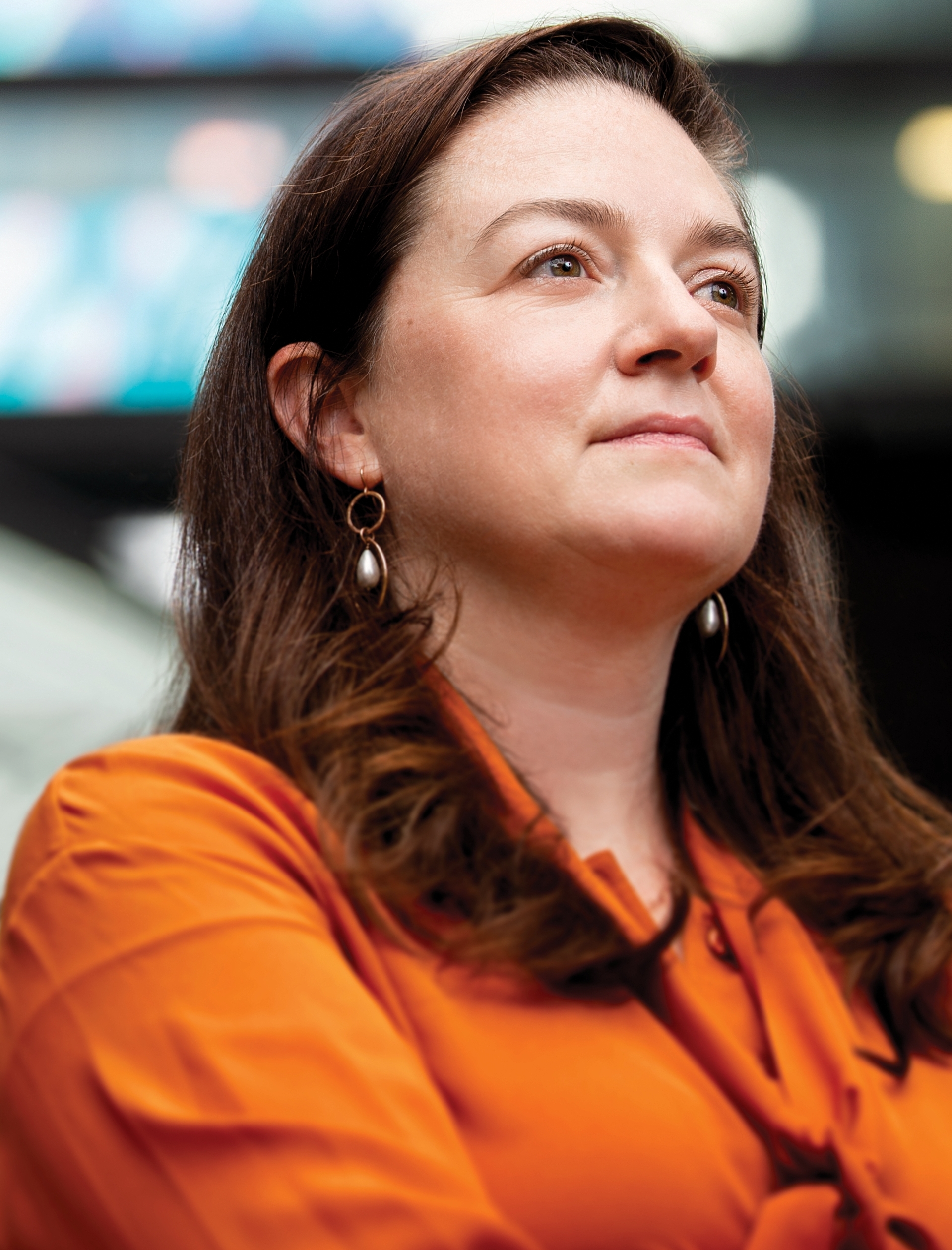Hospital-at-home care promises to reshape healthcare delivery in the United States

Hospital care in the United States is headed home. And the movement, which received a boost from a CMS waiver, has captured the attention and imagination of many healthcare leaders who recognize the benefits of home-based hospital care for improving patient outcomes and promoting greater patient satisfaction.
Those benefits have made Linda DeCherrie, MD, at Mount Sinai Health System in New York, New York, a strong believer in the potential of hospital-at-home care. “We have done studies showing we have higher patient satisfaction than in the bricks-and-mortar hospital, and we believe that comes from the much more personalized care we can deliver.”
Those conclusions make intuitive sense as well, she said, because patients are likely to feel reduced stress from being in the familiarity of their own homes, where they can feel more comfortable moving around, especially when compared with the austerity of being in a hospital bed. And logically, the model could help reduce the risk of hospital-acquired infections.
Such benefits, coupled with Medicare payment support through the CMS waiver and similar models adopted by commercial payers, could fuel even greater growth in hospital-at-home programs.
DeCherrie, who is clinical director of Mount Sinai at Home, said a hospital-at-home program also can be instrumental in promoting cost effectiveness of health — improved outcomes at lower patient costs — including accounting for social determinants of health (SDoH). Care providers can more easily perceive patients’ real-life circumstances, she said, so they are in a better position to assist patients in dealing with challenges stemming from SDoH, which also can contribute to greater satisfaction among both patients and care providers.
“If you are a clinician, nurse or doctor, it helps when you’re in the home of a patient who may have often been in the hospital with heart failure exacerbations,” DeCherrie said. “You can see, for example, the kind of food that they’re eating. And you’re finally able to say, ‘Mr. Smith, this food here has so much salt. Let me suggest some alternatives.’ That makes a big difference in the patient’s care, which can be reaffirming to the care provider, as well. Granted, that’s not the bread and butter of what we do, which is medical treatment just like the hospital would provide. But once you’re there, these other things are identified.”
Having better insight into the patient’s circumstances is also cited as a benefit of hospital-at-home care by Michael Dalton, vice president, virtual care enterprise, at The MetroHealth System in Cleveland. Like Mount Sinai, MetroHealth has invested deeply in developing a hospital-at-home program.

“Going into somebody’s home, you need to understand their social situation so you can better support that patient and deliver the appropriate care,” Dalton said. “You have to ask, ‘Is it safe for both the patient and for your workforce?’ It really flips that model on its head, because it’s about the patient inviting that care team into their home, not the hospital opening its doors to the patient.”
CMS’s waiver
Mount Sinai and MetroHealth leaders’ belief in the potential of hospital-at-home care prompted them to apply for CMS’s Acute Hospital Care at Home waiver, which the agency announced November 2020 as a way to relieve pressures on hospitals from the pandemic and help them protect inpatients from exposure to infection from COVID-19.a Under the program, qualifying hospitals can be paid at Medicare inpatient rates for certain services provided in a patient’s home, where previously hospitals could receive those rates only if the services were delivered in the hospital.
And the waiver has been well received, with more than 175 hospitals having been approved for participation as of Oct. 18, 2021.
DeCherrie noted that one factor that makes the waiver attractive is that it allows a lot of leeway in assessing program costs.
“Even if we didn’t get the exact number right for how much money to transfer to this program, it’s an internal cost: Medicare is still paying the same rate for an admission,” DeCherrie said. “If a patient is two days in the hospital and then two days at home, or all four days at home, it doesn’t matter to Medicare. CMS pays Mount Sinai, and the hospital then works on the downstream to our program.”
Weighing the opportunity
Health systems considering a hospital-at-home strategy need to be clear about their reasons for pursuing it, said Linda DeCherrie, MD, clinical director of Mount Sinai at Home. “You need to be asking yourself, ‘Why would we want to have patients hospitalized at home instead of in our own bricks-and-mortar building?’”
Reasons might include:
- It’s really expensive to build new buildings — maybe you don’t have the real estate space to expand.
- For meeting the terms of value-based contracts with insurers. If you can provide excellent or better care in a different, less-expensive location, that’s helpful for these contracts.
- Makes it easier to change clinical departments by freeing up hospital beds.
The prime ingredient: Executive commitment
Other advantages aside, DeCherrie said, the success of the care model depends first and foremost on the support of healthcare leaders who are at the vanguard of the trend toward increasingly delivering healthcare to patients in their homes. An organization’s executive leaders need to passionately believe in the model’s potential, DeCherrie said.
“You need to have buy-in from your executive leadership,” she said. “That’s because getting a program started really does touch every part of your hospital.”
DeCherrie realized the scope of the undertaking after she started working on the hospital-at-home program. She found there were many people at Mount Sinai she hadn’t had the opportunity to work with before who she would now need to interact with because of the program, including nutrition, the legal team, patient transport and bed management.
“All these pieces are so important,” she said. “You need to think of this as building another wing of your hospital, because although patients are hospitalized at home, they are in a virtual unit of the hospital that must comply with all the rules and regulations of a hospitalization. And you can’t take on that kind of project if there isn’t senior executive support for it at the start.”
DeCherrie also is not alone in asserting that executive buy-in from the start is a critical ingredient. MetroHealth’s Dalton likewise attributes the existence of his organization’s hospital-at-home initiative to the commitment of the organization’s C-suite to the idea.
“Our CEO and president, Dr. Akram Boutros, and our chief clinical transformation officer, Dr. Nabil Chehade, have long had a vision for hospital in the home, so far as to eventually provide ICU levels of care in the home,” Dalton said. “And our COO and our chief clinical officer also saw a very tangible benefit in applying for CMS’s waiver, because we have been above capacity within our hospital for quite some time. They saw value in the hospital-at-home approach because it was creating an ability to care for more patients.”
MetroHealth’s leaders also see a positive response from patients as a key benefit of the model, Dalton noted.
“We think as we get into a post-pandemic world, these models will continue to mature, because we also think this is just a better model of care,” Dalton said. “And once consumers are aware that it is an option, they’re going to want to see it more and more. Whether that’s hospital care in the home or physical therapy or other services, if it’s an option, they will choose it. That’s going to make the investment worthwhile.”

The program’s well-documented effectiveness is another compelling factor, according to Shawn Stack, HFMA’s director, perspectives and analysis.
“These programs continue to gain traction because they have been shown to be effective in reducing complications while cutting the cost of care by 20% or more, with many programs showing higher satisfaction ratings among patients, providers and family caregivers,” Stack said. “It’s truly patient-centered care. And it’s made possible through advances in telemedicine, remote monitoring and the ability to set up safe alternative care settings outside a traditional hospital’s four walls.”
Beyond CMS’s waiver
Both DeCherrie and Dalton stressed that the hospital-at-home model is not new. “It’s been here in the United States for close to probably 20 years now, and it has seen widespread use in Europe and Australia for even longer,” Dalton said. “We’re starting to see it accelerate here, too, and just as with virtual visits, I don’t think there’s any going back for the hospital-at-home model, and not just because patients will want it. There has been a groundswell of health systems participating in the program.”
DeCherrie’s organization, Mount Sinai, was well on its way to developing a hospital-at-home program before CMS announced its waiver. They already had obtained Medicare Advantage, commercial and managed Medicaid insurance contracts prior to the pandemic.
And insurers were receptive to the idea.
“When you go to a meeting with the health insurer and you are talking with its medical directors, they often get it right away,” DeCherrie said. “They can see the data — really good outcomes and patients are satisfied — and they’re excited. And then you tell the CFOs, you’re going to do a discount, and they say, ‘That sounds great.’ So those two folks are very excited.
“Then you get the operations people in, and start asking, ‘How are we going to do this?’ That’s where it gets complicated because there are different ways to approach it. We do 30-day bundles of care.”
For Medicare fee-for-service, patients always start out in the hospital, DeCherrie noted. Patients can be admitted directly from the emergency department (ED), or they might stay a night or two in the hospital, because they’re too sick to go right home, and then finish the last couple of days at home.
“That’s what’s required for Medicare,” DeCherrie said. “But for our Medicare Advantage bundles, we sometimes can admit patients directly from an office under particular circumstances.”
Program setup and expectations
Starting a hospital-at-home program is challenging because it must be up and running around the clock from the very start.
“This is hospital-level care,” DeCherrie said. “It’s not like a doctor who’s starting a new program for outpatients, who will add another half day a week of doing something, and then not be available the rest of the week.
The doctors need to be 24/7 on call. And you need to have emergency services that can go to the home lined up 24/7 at the very start. Then, you might only admit one patient in the first week.”
Although Mount Sinai set up quickly during the pandemic, it also is continually reevaluating the program’s actual cost. “Clearly, there is an upfront cost,” DeCherrie said. “But if you think it through and look at what kind of patients you have, which insurance and your geography, you should have all that data you need to accurately predict what it will look like and when you might be able to recoup.”
Hospital-at-home care: How it works
Linda DeCherrie, MD, clinical director of Mount Sinai at Home, described some of the basic components of her organization’s approach to hospital-at-home care, which includes telemedicine:
- The hospital patient goes home with a telehealth kit, which includes an iPad-like tablet, a blood pressure cuff, pulse socks and a scale.
- The patient receives training from a nurse on how to use the technology, which begins when the patient is hospitalized.
- Patients must receive two nursing visits a day, per state regulations, which can include visits from paramedics.
- Patients also receive one provider visit per day, and about half of the provider visits are virtual versus in-person.
- The program has a phlebotomist and a physical therapist who come into the home.
- A social worker is available for virtual or in-person visits, depending on what’s needed.
- The program is available 24/7, and it can send out paramedics anytime to rapidly see a patient. The paramedic will then video with the physician who is online.
Dalton likewise underscored the challenges of setting up a hospital-at-home program.
“I would liken this to a marathon that you are running at almost a 400- to 800-meter clip,” he said. “It is hard because there are so many distractions and competing interests and priorities. But you have to stay focused on having that first patient be able to go home.”
Dalton attributed MetroHealth’s success in implementing the program to having a team approach, where he as business leader has been working in concert with an operational leader and clinical leader on the process. “Without that three-pillar alignment, you can’t make progress at the speed necessary for this to be successful,” he said.
One of the biggest challenges Dalton noted was the need for an entirely different set of policies and workflows. “That is something you should not underestimate,” he said. “It takes a lot of time, for example to develop policies for transferring patients to the home or back to the hospital. And we also spent a considerable time working with our pharmacy team just to be consistent with things like how we are going to prescribe medications and from where they would be dispensed.”
A critical task also not to be underestimated, cited by both Dalton and DeCherrie, is preparing the electronic health record (EHR) for hospital-at-home care.
“It’s not so much the build itself,” DeCherrie said. “It’s also that you need a lot of lead time to pull together all the pieces that are required for the build.”
Dalton pointed to the need to negotiate an internal information system governance process as a preliminary step.
“We needed to set up that process first to be able to get the funding for resources necessary to build out that unit,” Dalton said. “We built a virtual inpatient unit within Epic in a pretty remarkable fashion within 60 days. It was a guiding principle for us to make sure that the same level of care that we would provide on the floor we could do in the home. And for us, having access to our EHR for that purpose was key.”
Another key challenge is acquiring the staffing and expertise for hospital-at-home care. “We have drawn from an ocean of internal resources to stand up and operationalize the model,” Dalton said. “But a major challenge was that we didn’t have a home health agency or a workforce that is accustomed to delivering care in the home. So we partnered with a home health agency to benefit from their familiarity with delivering care in the home, and they have helped us identify nurses from their internal staff to work with us in this model.”
A growing imperative for at-home hospital care
Beyond COVID-19, the hospital-at-home movement holds a promise for addressing growing challenges facing the U.S. healthcare system into the future.“Medicare enrollment is projected to increase by almost 50% over the next 15 years from 54 million beneficiaries today to more than 80 million in 2030,” said HFMA’s Stack. “Hospital-at-home programs help ensure patients with serious chronic illness and maladies of aging can remain as independent as possible while receiving cost-effective care in an environment that promotes dignity and family support. It is also important to acknowledge that cost-saving approaches such as CMS’s Acute Care at Home waiver also help address financial strains that continue to mount for our Medicare and Medicaid programs,”
he said.
These realities make hospital at home not only compelling but also imperative for improving healthcare delivery in the United States.
6 lessons learned from launching a hospital-at-home program
Two health system leaders, Linda DeCherrie, MD, at Mount Sinai Health System and Michael Dalton, at the MetroHealth System, shared six lessons learned from their experience in setting up a hospital-at-home program.
1. Make sure the program has the full support from executive leadership. “If you don’t have their complete buy-in for it, then you won’t get the direction that this initiative requires to move forward”, DeCherrie said.
2. Set a reasonable expectation for the time needed to ramp up the program. “It could take two to three years, to achieve volumes of, say, a micro hospital,” said Dalton. “If you have 10 to 12 patients, that’s still a yeoman’s effort and something to be applauded.
3. Make sure you allow ample time to prepare your EMR for the program. “The challenge is not in the build itself; it’s in anticipating the lead time required to quickly pull together the resources for the EMR,” DeCherrie said.
4. Identify a clinical champion to help lead the effort. “You need somebody on the clinical side who is dedicated and passionate about it,” Dalton said.
5. Give priority to lining up the requisite nursing staff. “You have to fi nd nurses who are comfortable with acute medicine, like inpatient medicine, but also comfortable being in the home,” DeCherrie said.
6. Take advantage of industry resources that can support the effort. “We’ve been working with a group called the Hospital-at-Home Users Group [hahusersgroup.org], which is a terrific resource,” Dalton said. “I believe you could build your program just in working with the resources that they’ve made publicly available.” DeCherrie is one of the group’s four leaders.
Footnote
a. CMS.gov, “Acute-hospital-care-at home,” Page accessed Oct. 18, 2021.





